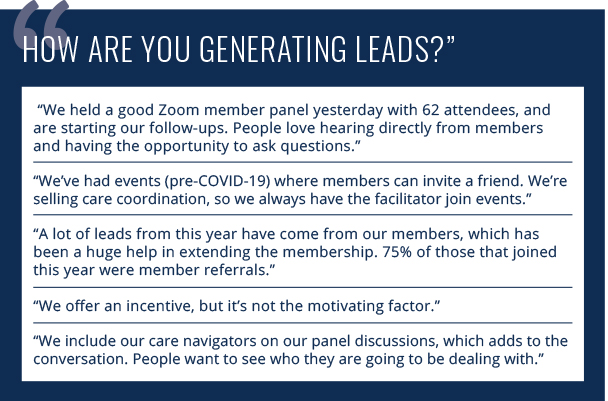Derek
By Derek Dunham, President
Tricks and Treats in Community Sales: October Roundtable Roundup
The treats for senior living communities this October included lots of interest from prospects. The tricky part? Staffing issues and COVID-19-related restrictions made it tough for some organizations to take advantage of the momentum.
The Treats: Lots of Tours, Applications and Deposits
A participant in Washington state said, “Four of our areas (apartments, memory care, assisted living and duplexes) are all 100% full, and I’m not sure that’s ever been the case.” Another marketer in California agreed that business continues to be strong. “We’re going to have 10 move-ins in October. It’s really exciting to see.” And there’s good news from Arkansas as well: “Sales for our new neighborhood are good, with 43 of 53 units sold.”

Communities are also trying creative new tactics for bringing in business. One participant from Wisconsin said, “We’ve been really rocking and rolling. For the first time, we offered a promotion of 10% off the entrance fee to people who sign up now, and we’ve had lots of success with it.”
The Tricks: COVID-19 Restrictions and Staff Shortages
Scary Shutdowns
Something that could scare off prospects: Communities shutting down to visitors because of local COVID-19 restrictions. One marketer shared, “We’re talking about taking everything online again.” A second participant said, “We’re unable to do events, so it’s frustrating.” And a third marketer added, “I’m seeing more restrictions. It’s sad having to see people tap the brakes.”

In some cities, however, it’s nearly business as usual. One participant from Virginia said, “Our team members are all fully vaccinated — it’s a requirement, and I think that’s helped because a lot of prospects asked that question. We’ve been busy giving tours and adding people to the waiting list.”
Creative Hybrid Events
One way of solving the dilemma when prospects are worried about attending in-person seminars: Hold a hybrid event. “As far as marketing events, we have a hybrid event — in person and on Zoom as well, so people can choose to do either,“ a participant shared.

Industry-Wide Staff Shortages
Staffing shortages continue to be a roadblock to sales. One marketer shared, “We’re getting calls and inquiries, but we don’t have enough staff to keep up with the volume … we had to turn down seven people last week who wanted to move in!” A participant in Arkansas agreed. “Our nursing home is desperately looking for staff and we’re having a difficult time finding applicants.” Another marketer shared, “This is the #1 thing on everyone’s minds — how will we deal with this?” One final comment: “We have a waitlist that’s two pages long. We don’t have the staff at the higher levels of care to cover all the interest.”

Innovative Solutions for Recruiting Staff
When we asked participants if they’d found any effective methods for recruitment in these challenging times, they shared these creative ideas:
- Drive-through career fairs: “We had another drive-through career fair in August, which was successful. They have been fun and an interesting way to get people onto campus.”
- Diversity and inclusion: “We have a resident committee here working hard at looking at diversity and inclusion.”
- Salary hikes: “The board moved our minimum starting wage to $15 per hour, so some will get up to a 40% raise in November.”
- Using staffing firms: Several firms participated in the recent LeadingAge conference, including: Fusion Medical Staffing, Gale Healthcare Solutions, Hireology, OnShift, Intelycare, Prime Time Healthcare and ShiftMed. (Varsity is not endorsing any of these firms; rather, merely providing information.)
Holiday Tactics for Targeting Adult Children
Heading into the holidays, some communities are targeting adult children (but not necessarily with in-person events). One participant shared, “We changed our media messages to target adult children more.” Another marketer said, “We put together a one-sheet guide of tips on how to talk about things with your parents.” A third community published an article in a local magazine about ways to connect with adult children who are raising their kids and caring for their parents as well.
Notes From the 2021 LeadingAge Conference
Held October 24-27 in Atlanta, Georgia, the first LeadingAge conference since COVID-19 had lighter attendance than usual, but some fascinating presentations. The major focus? “Technology, technology, technology,” said Derek Dunham, who attended with his Varsity colleagues. For instance, Amazon launched its new senior living product with an enterprise solution. You can read about it in this Senior Housing News article. Varsity, sister firm WildFig Data and Ingleside also presented a session with a technology focus: “Predictive Analytics: Connecting Past Performance to Future Success.”
Look for our next monthly roundtable recap in your inbox. Until then, please be sure to join our weekly Sales & Marketing Roundtable on Thursdays at noon ET, 11 a.m. CT and 9 a.m. PT.
For login information, email DDunham@varsitybranding.com.












